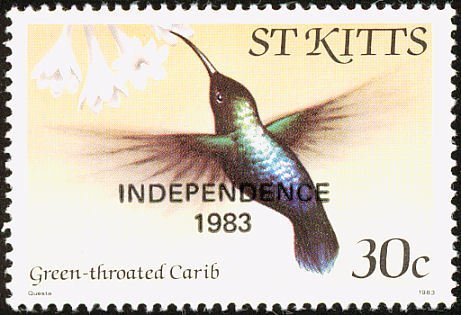#saint christopher
Like much of the West Indies, St. Kitts and Nevis has gone through a number of iterations in its history since being colonized by the Europeans, including historically having Anguilla be part of the federation (until it seceded at the time of independence to remain a British Overseas Territory). Saint Kitts (also known as Saint Christopher) appears to have misnamed on early maps [likely it was supposed to have been Saint James, named by Columbus, but was misprinted as San Cristóbal, which name stuck with early English colonists who, as we know, take delight in nicknames, Kitt being a favorite shortening of Christopher], while Nevis is a mistransliteration of the Spanish Nieves (for Our Lady of the Snows). St. Kitts and Nevis gained Associated State status in 1967, then full independence in 1983, but remains a part of the Commonwealth of Nations.
Stamp details:
Top left:
Issued on: July 19, 1862
From: Charlestown, Nevis
MC #1
Top middle:
Issued on: April 1, 1870
From: Basseterre, Saint Christopher
MC #1
Top right:
Issued in: 1903
From: Basseterre, Saint Kitts and Nevis
MC #1
Second row:
Issued on: February 27, 1967
From: Basseterre, Saint Christopher-Nevis-Anguilla
MC #177
Third row left:
Issued on: September 4, 1980
From: Basseterre, Saint Kitts
MC #39
Third row right:
Issued on: September 4, 1980
From: Charlestown, Nevis
MC #38
Fourth row left:
Issued on: September 19, 1983
From: Basseterre, Saint Kitts
MC #111
Fourth row right:
Issued on: September 19, 1983
From: Charlestown, Nevis
MC #100
Bottom left:
Issued on: April 14, 2016
From: Basseterre, Saint Kitts
MC #1541
Bottom right:
Issued on: April 1, 2016
From: Charlestown, Nevis
MC #3143
Recognized as a sovereign state by the UN: Yes (since September 23, 1983)
Official name: Saint Kitts and Nevis; Federation of Saint Christopher and Nevis
Member of the Universal Postal Union: Yes (since January 11, 1988)
Post link
“In the stories discussed above, we have already seen elements or tinges of jealous passion intruding occasionally into otherwise innocent feelings of paternal devotion. There are, however, certain tales in which the father’s feelings about the daughter, or his actions in connection with her role as bride, exceed the bounds of propriety. This is perhaps most evident in those stories in which the father one way or another becomes involved in what transpires in the bridal chamber on the wedding night. To be sure, in “Hans My Hedgehog” (KHM 108) this involvement occurs at the bridegroom’s request: he tells the old king that he should have four men stand guard before the door and make a large fire, in which they are to burn the skin the hedgehog will shed just before he climbs into the marriage bed.
Once this has happened and Hans is lying in the bed “completely in human form, but … black as coal as though he had been burned,” the king calls for his physician, who washes the bridegroom “with good salves and covers him with ointments” so that he is transformed into a handsome young man, very much to the daughter’s delight. In “The Two Royal Children” (KHM 113), though, a father’s jealous love of his daughters, and accompanying envy of the suitor as prospective bridegroom, is indicated by his condition that if the young prince is to have one of the daughters to wife, he must remain awake in her bedroom for nine hours–from nine in the evening to six in the morning–without falling asleep.
The– ironic–implication of the father’s odd demand may be that he imagines that in this way the young man will be prevented from “sleeping” with the daughter and will thus have to suffer the torments of unfulfilled desire. As it happens, the eldest daughter and the two younger ones after her trick the father by having the statues of St. Christopher standing in their rooms answer each hour for the young man, who thereby passes the test despite having fallen asleep in the girls’ bedrooms (there is no indication that he engages in any intimacy with them, except the laconic reports that he “laid himself on the threshold”).








